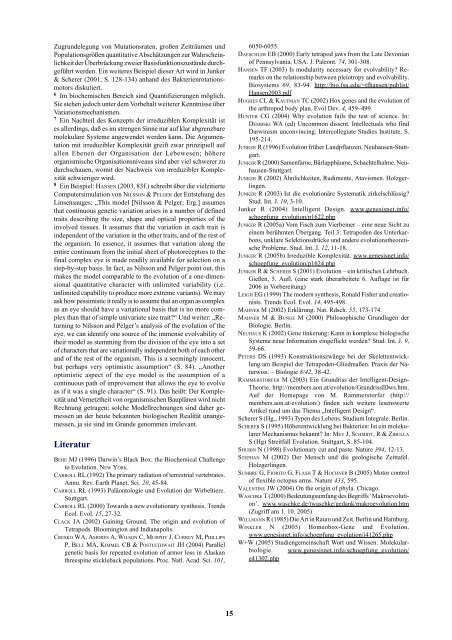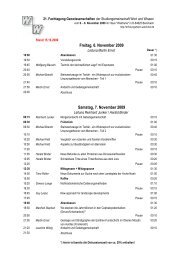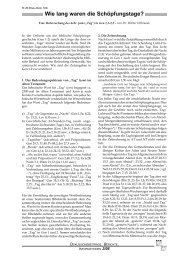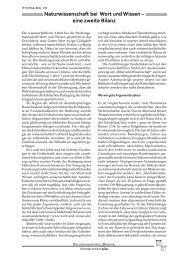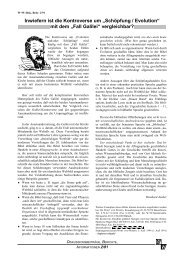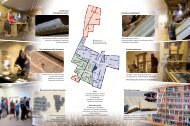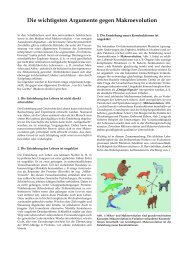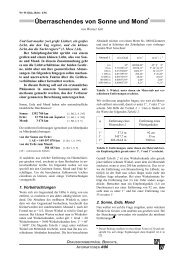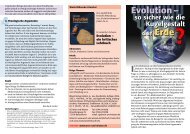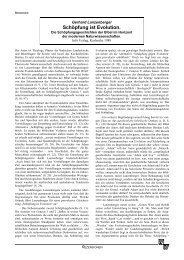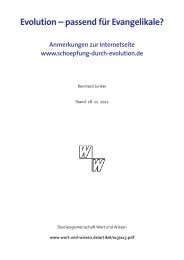Was erklärt die Evolutionstheorie? - Wort und Wissen
Was erklärt die Evolutionstheorie? - Wort und Wissen
Was erklärt die Evolutionstheorie? - Wort und Wissen
Sie wollen auch ein ePaper? Erhöhen Sie die Reichweite Ihrer Titel.
YUMPU macht aus Druck-PDFs automatisch weboptimierte ePaper, die Google liebt.
Zugr<strong>und</strong>elegung von Mutationsraten, großen Zeiträumen <strong>und</strong><br />
Populationsgrößen quantitative Abschätzungen zur Wahrscheinlichkeit<br />
der Überbrückung zweier Basisfunktionszustände durchgeführt<br />
werden. Ein weiteres Beispiel <strong>die</strong>ser Art wird in Junker<br />
& Scherer (2001, S. 128-134) anhand des Bakterienrotationsmotors<br />
diskutiert.<br />
6 Im biochemischen Bereich sind Quantifizierungen möglich.<br />
Sie stehen jedoch unter dem Vorbehalt weiterer Kenntnisse über<br />
Variationsmechanismen.<br />
7 Ein Nachteil des Konzepts der irreduziblen Komplexität ist<br />
es allerdings, daß es im strengen Sinne nur auf klar abgrenzbare<br />
molekulare Systeme angewendet werden kann. Die Argumentation<br />
mit irreduzibler Komplexität greift zwar prinzipiell auf<br />
allen Ebenen der Organisation der Lebewesen; höhere<br />
organismische Organisationsniveaus sind aber viel schwerer zu<br />
durchschauen, womit der Nachweis von irreduzibler Komplexität<br />
schwieriger wird.<br />
8 Ein Beispiel: HANSEN (2003, 83f.) schreibt über <strong>die</strong> vielzitierte<br />
Computersimulation von NILSSON & PELGER der Entstehung des<br />
Linsensauges: „This model [Nilsson & Pelger; Erg.] assumes<br />
that continuous genetic variation arises in a number of defined<br />
traits describing the size, shape and optical properties of the<br />
involved tissues. It assumes that the variation in each trait is<br />
independent of the variation in the other traits, and of the rest of<br />
the organism. In essence, it assumes that variation along the<br />
entire continuum from the initial sheet of photoreceptors to the<br />
final complex eye is made readily available for selection on a<br />
step-by-step basis. In fact, as Nilsson and Pelger point out, this<br />
makes the model comparable to the evolution of a one-dimensional<br />
quantitative character with unlimited variability (i.e.<br />
unlimited capability to produce more extreme variants). We may<br />
ask how pessimistic it really is to assume that an organ as complex<br />
as an eye should have a variational basis that is no more complex<br />
than that of simple univariate size trait?“ Und weiter: „Returning<br />
to Nilsson and Pelger’s analysis of the evolution of the<br />
eye, we can identify one source of the immense evolvability of<br />
their model as stemming from the division of the eye into a set<br />
of characters that are variationally independent both of each other<br />
and of the rest of the organism. This is a seemingly innocent,<br />
but perhaps very optimistic assumption“ (S. 84). „Another<br />
optimistic aspect of the eye model is the assumption of a<br />
continuous path of improvement that allows the eye to evolve<br />
as if it was a single character“ (S. 91). Das heißt: Der Komplexität<br />
<strong>und</strong> Vernetztheit von organismischen Bauplänen wird nicht<br />
Rechnung getragen; solche Modellrechnungen sind daher gemessen<br />
an der heute bekannten biologischen Realität unangemessen,<br />
ja sie sind im Gr<strong>und</strong>e genommen irrelevant.<br />
Literatur<br />
BEHE MJ (1996) Darwin’s Black Box: the Biochemical Challenge<br />
to Evolution. NEW YORK.<br />
CARROLL RL (1992) The primary radiation of terrestrial vertebrates.<br />
Annu. Rev. Earth Planet. Sci. 20, 45-84.<br />
CARROLL RL (1993) Paläontologie <strong>und</strong> Evolution der Wirbeltiere.<br />
Stuttgart.<br />
CARROLL RL (2000) Towards a new evolutionary synthesis. Trends<br />
Ecol. Evol. 15, 27-32.<br />
CLACK JA (2002) Gaining Gro<strong>und</strong>. The origin and evolution of<br />
Tetrapods. Bloomington and Indianapolis.<br />
CRESKO WA, AMORES A, WILSON C, MURPHY J, CURREY M, PHILLIPS<br />
P, BELL MA, KIMMEL CB & POSTLETHWAIT JH (2004) Parallel<br />
genetic basis for repeated evolution of armor loss in Alaskan<br />
threespine stickleback populations. Proc. Natl. Acad. Sci. 101,<br />
15<br />
6050-6055.<br />
DAESCHLER EB (2000) Early tetrapod jaws from the Late Devonian<br />
of Pennsylvania, USA. J. Paleont. 74, 301-308.<br />
HANSEN TF (2003) Is modularity necessary for evolvability? Remarks<br />
on the relationship between pleiotropy and evolvability.<br />
Biosystems 69, 83-94. http://bio.fsu.edu/~tfhansen/publist/<br />
Hansen2003.pdf<br />
HUGHES CL & KAUFMAN TC (2002) Hox genes and the evolution of<br />
the arthropod body plan. Evol Dev. 4, 459–499.<br />
HUNTER CG (2004) Why evolution fails the test of science. In:<br />
DEMBSKI WA (ed) Uncommon dissent. Intellectuals who find<br />
Darwinism unconvincing. Intercollegiate Stu<strong>die</strong>s Institute, S.<br />
195-214.<br />
JUNKER R (1996) Evolution früher Landpflanzen. Neuhausen-Stuttgart.<br />
JUNKER R (2000) Samenfarne, Bärlappbäume, Schachtelhalme. Neuhausen-Stuttgart.<br />
JUNKER R (2002) Ähnlichkeiten, Rudimente, Atavismen. Holzgerlingen.<br />
JUNKER R (2003) Ist <strong>die</strong> evolutionäre Systematik zirkelschlüssig?<br />
Stud. Int. J. 10, 3-10.<br />
Junker R (2004) Intelligent Design. www.genesisnet.info/<br />
schoepfung_evolution/p1622.php<br />
JUNKER R (2005a) Vom Fisch zum Vierbeiner – eine neue Sicht zu<br />
einem berühmten Übergang. Teil 3: Tetrapoden des Unterkarbons,<br />
unklare Selektionsdrücke <strong>und</strong> andere evolutionstheoretische<br />
Probleme. Stud. Int. J. 12, 11-18.<br />
JUNKER R (2005b) Irreduzible Komplexität. www.genesisnet.info/<br />
schoepfung_evolution/p1624.php<br />
JUNKER R & SCHERER S (2001) Evolution – ein kritisches Lehrbuch.<br />
Gießen, 5. Aufl. (eine stark überarbeitete 6. Auflage ist für<br />
2006 in Vorbereitung)<br />
LEIGH EG (1999) The modern synthesis, Ronald Fisher and creationists.<br />
Trends Ecol. Evol. 14, 495-498.<br />
MAHNER M (2002) Erklärung. Nat. Rdsch. 55, 173-174.<br />
MAHNER M & BUNGE M (2000) Philosophische Gr<strong>und</strong>lagen der<br />
Biologie. Berlin.<br />
NEUHAUS K (2002) Gene tinkerung: Kann in komplexe biologische<br />
Systeme neue Information eingeflickt werden? Stud. Int. J. 9,<br />
59-66.<br />
PETERS DS (1993) Konstruktionszwänge bei der Skelettentwicklung<br />
am Beispiel der Tetrapoden-Gliedmaßen. Praxis der Naturwiss.<br />
– Biologie 8/42, 38-42.<br />
RAMMERSTORFER M (2003) Ein Gr<strong>und</strong>riss der Intelligent-Design-<br />
Theorie. http://members.aon.at/evolution/Gr<strong>und</strong>rissIDws.htm.<br />
Auf der Homepage von M. Rammerstorfer (http://<br />
members.aon.at/evolution/) finden sich weitere lesenswerte<br />
Artikel r<strong>und</strong> um das Thema „Intelligent Design“.<br />
Scherer S (Hg., 1993) Typen des Lebens. Studium Integrale. Berlin.<br />
SCHERER S (1995) Höherentwicklung bei Bakterien: Ist ein molekularer<br />
Mechanismus bekannt? In: MEY J, SCHMIDT, R & ZIBULLA<br />
S (Hg) Streitfall Evolution. Stuttgart, S. 85-104.<br />
SHUBIN N (1998) Evolutionary cut and paste. Nature 394, 12-13.<br />
STEPHAN M (2002) Der Mensch <strong>und</strong> <strong>die</strong> geologische Zeittafel.<br />
Holzgerlingen.<br />
SUMBRE G, FIORITO G, FLASH T & HOCHNER B (2005) Motor control<br />
of flexible octopus arms. Nature 433, 595.<br />
VALENTINE JW (2004) On the origin of phyla. Chicago.<br />
WASCHKE T (2000) Bedeutungsumfang des Begriffs ‘Makroevolution’.<br />
www.waschke.de/twaschke/gedank/makroevolution.htm<br />
(Zugriff am 1. 10. 2005)<br />
WILLMANN R (1985) Die Art in Raum <strong>und</strong> Zeit. Berlin <strong>und</strong> Hamburg.<br />
WINKLER N (2005) Homeobox-Gene <strong>und</strong> Evolution.<br />
www.genesisnet.info/schoepfung_evolution/i41265.php<br />
W+W (2005) Stu<strong>die</strong>ngemeinschaft <strong>Wort</strong> <strong>und</strong> <strong>Wissen</strong>: Molekularbiologie.<br />
www.genesisnet.info/schoepfung_evolution/<br />
e41302.php


